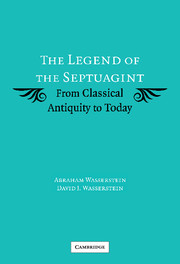Book contents
- Frontmatter
- Contents
- Preface and Acknowledgments
- Abbreviations
- Introduction
- 1 The Letter of Aristeas
- 2 The Hellenistic Jewish Tradition
- 3 The Rabbis and the Greek Bible
- 4 The Ptolemaic Changes
- 5 The Church Fathers and the Translation of the Septuagint
- 6 Among the Christians in the Orient
- 7 The Muslims and the Septuagint
- 8 Yosippon and the Story of the Seventy
- 9 Karaites, Samaritans and Rabbanite Jews in the Middle Ages
- 10 The Septuagint in the Renaissance and the Modern World
- Conclusion
- Appendix: In Partibus Infidelium: Zosimus of Panopolis
- Bibliography and Sources
- Index
8 - Yosippon and the Story of the Seventy
Published online by Cambridge University Press: 17 July 2009
- Frontmatter
- Contents
- Preface and Acknowledgments
- Abbreviations
- Introduction
- 1 The Letter of Aristeas
- 2 The Hellenistic Jewish Tradition
- 3 The Rabbis and the Greek Bible
- 4 The Ptolemaic Changes
- 5 The Church Fathers and the Translation of the Septuagint
- 6 Among the Christians in the Orient
- 7 The Muslims and the Septuagint
- 8 Yosippon and the Story of the Seventy
- 9 Karaites, Samaritans and Rabbanite Jews in the Middle Ages
- 10 The Septuagint in the Renaissance and the Modern World
- Conclusion
- Appendix: In Partibus Infidelium: Zosimus of Panopolis
- Bibliography and Sources
- Index
Summary
Around the turn of the Christian millennium, there are major changes in the way our legend is treated among the Jews. These derive from a new text, that known under the name of Yosippon. Most of the other texts of Jewish background up to the sixteenth century that we shall consider here are touched by Yosippon in one way or another, reflecting the position of importance, even dominance, which that work attained in Jewish literary culture.
Sepher Yosippon (Josippon), the Book of Yosippon, was produced probably in the tenth century, perhaps in southern Italy, originally in Hebrew, though this may not be true for all of it. It pretended to be a Hebrew version of the work of Josephus. (Hence the name Yosippon, a Hebraisation of that name.) We have no idea of the identity of the author. The text covers some of the same ground as Josephus and uses authentic material from that writer. It is less of a real history, tending more to the fantastic and the fanciful. Versions of this work are known in many and varied languages, including Arabic, Ethiopic, Old Russian, Latin, German, French, English, Czech, Polish, Yiddish and Ladino. Those into Arabic, Ethiopic and Old Russian, unlike the rest, antedate the age of printing. We still lack editions of these versions; the textual relationships between these and other texts are unclear, and matters are complicated still further by the fact that the work, like that of Josephus himself, became early the object of special interest among Christians in Europe because of alleged references in it to Jesus.
- Type
- Chapter
- Information
- The Legend of the SeptuagintFrom Classical Antiquity to Today, pp. 192 - 216Publisher: Cambridge University PressPrint publication year: 2006



